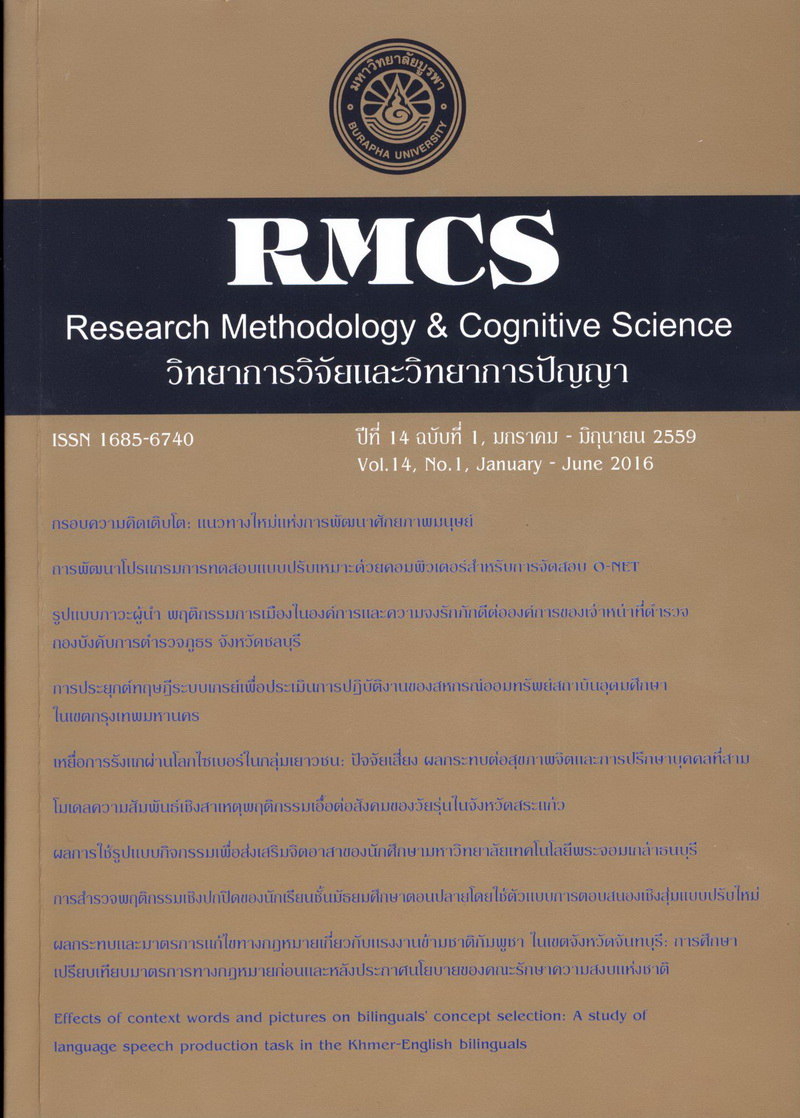การสำรวจพฤติกรรมเชิงปกปิดของนักเรียนชั้นมัธยมศึกษาตอนปลาย โดยใช้ตัวแบบการตอบสนองเชิงสุ่มแบบปรับใหม่
Main Article Content
บทคัดย่อ
การวิจัยนี้มีวัตถุประสงค์เพื่อพัฒนาตัวแบบการตอบสนองเชิงสุ่มแบบปรับใหม่จากวิธีของ Kim and Warde
( 2005) และส ารวจพฤติกรรมเชิงปกปิดของนักเรียนชั้นมัธยมศึกษาตอนปลาย โดยใช้ตัวแบบการตอบสนองเชิงสุ่ม
แบบปรับใหม่ วิธีการวิจัยแบ่งออกเป็น 2 ตอน ประกอบด้วย การพัฒนาตัวแบบการตอบสนองเชิงสุ่มแบบปรับใหม่
และการส ารวจพฤติกรรมเชิงปกปิดของนักเรียนชั้นมัธยมศึกษาตอนปลายในจังหวัดตรัง โดยใช้ตัวแบบการตอบสนอง
เชิงสุ่มแบบปรับใหม่ ใน 4 ประเด็น ได้แก่ พฤติกรรมทางเพศ การเสพยาเสพติด การเล่นการพนัน และพฤติกรรม
ความไม่ซื่อสัตย์
ผลการวิจัยปรากฏดังนี้
1. ตัวแบบการตอบสนองเชิงสุ่มแบบปรับใหม่ เป็นการพัฒนาตัวแบบการตอบสนองเชิงสุ่มจากวิธีของ
Kim and Warde (2005) โดยสุ่มเลือกค าถาม ประกอบด้วย ค าถามปกปิด ค าถามทั่วไป และค าถามเปล่า เพื่อให้
ผู้ตอบตอบค าถามได้ตรงกับความเป็นจริงและป้องกันความเป็นส่วนตัวของผู้ตอบค าถามให้มากขึ้น
2. ผลการส ารวจพฤติกรรมเชิงปกปิดของนักเรียนชั้นมัธยมศึกษาตอนปลายในจังหวัดตรัง จ านวน 415
คน ปรากฏว่า นักเรียนชั้นมัธยมศึกษาตอนปลาย มีพฤติกรรมเชิงปกปิดในด้านพฤติกรรมทางเพศมากที่สุดร้อยละ
32.71 โดยส่วนใหญ่คิดว่าการมีเพศสัมพันธ์ในวัยเรียนและการอยู่กินฉันท์สามีภรรยากับคู่รักก่อนแต่งงานเป็นเรื่อง
ปกติ รองลงมาคือ พฤติกรรมความไม่ซื่อสัตย์ร้อยละ 30.13 นักเรียนส่วนใหญ่เคยทุจริตในการสอบ และพฤติกรรม
เชิงปกปิดที่นักเรียนชั้นมัธยมศึกษาตอนปลายประพฤติมากเป็นอันดับที่ 3 คือ พฤติกรรมการเล่นการพนันร้อยละ
21.48 และพบพฤติกรรมการเสพยาเสพติดน้อยที่สุดร้อยละ 15.68 โดยส่วนใหญ่เคยดื่มสุราและสูบบุหรี่ แต่ไม่พบ
พฤติกรรมการเสพยาเสพติดที่ผิดกฎหมาย เช่น การเสพกัญชา ยาบ้า และยาอี
A survey of sensitive behavior of upper secondary school students using modified randomized response model
The objective of this research was to develop a modified randomized response model
of Kim and Warde (2005) model and to survey sensitive behavior of upper secondary school
students using modified randomized response model. The study was divided into two stages:
developing a modified randomized response model and survey sensitive behavior of upper
secondary school students using modified randomized response model in Trang province with
four behavioral aspects: sexual, drug addiction, gambling, and dishonest.
The results were as follows:
1. The modification was created by Kim and Warde (2005) randomized as a response
model, and consisted of introducing three question levels: a sensitive question, an innocuous
question, and a blank question. The modified Randomized Response Model was employed to
answer directly and to improve the privacy protection of respondents.
2. A survey sensitive behavior of upper secondary school students using modified
randomized response model in Trang province 415 respondents showed that the sexual behavior
had the highest percentage (32.71), most students think having sex and premarital sex are a
common issue. The second issue was dishonest behavior with the percentage of 30.13,
contributed to cheating on exams. The third issue was gambling behavior (21.48%), and drug
addiction behavior (15.68%); most of them drink alcohol and smoke; but no use of illegal drugs,
such as, marijuana, and amphetamine-like.
Article Details
เอกสารอ้างอิง
เฉลิมศรี ราชนาจันทร์ และศรีวรรณ มีคุณ. (2553). ปรากฏการณ์ชีวิตของเยาวชนผู้เสพยาบ้า. วารสารการศึกษา
และพัฒนาสังคม, 6(1), 81-94.
ตวงรัตน์ วาห์สะ. (2555). พฤติกรรมความซื่อสัตย์ของนักเรียนช่วงชั้นที่ 3 ในโรงเรียนสังกัดส านักงานเขตพื้นที่
การศึกษามัธยมศึกษาเขต 9 จังหวัดนครปฐม. วารสาร Veridian E-Journal บัณฑิตวิทยาลัย
มหาวิทยาลัยศิลปากร, 5(2), 643-669.
ผู้จัดการออนไลน์. (2557). น่าห่วง วัยรุ่นยังเสพยาบ้า/ดูดไอซ์มากสุด. สืบค้นเมื่อ 3 สิงหาคม 2557,
จาก http://www.manager.co.th/qol/ViewNews.aspx?NewsID=9570000065348
วีรพงษ์ พวงเล็ก. (2557). ปัจจัยเชิงเหตุของการเปิดรับเนื้อหาทางเพศบนสื่ออินเทอร์เน็ตที่มีต่อทัศนคติทางเพศ
ของวัยรุ่น. วารสารปัญญาภิวัฒน์, 5, 105-122.
ศูนย์ศึกษาปัญหาการพนัน. (2557). รายงานประจ าปี 2556 (พิมพ์ครั้งที่ 1). กรุงเทพฯ: โรงพิมพ์เครือข่ายเดือนตุลา.
อุมาภรณ์ ภัทรวาณิชย์. (2557). ทัศนคติทางเพศของประชากรรุ่นใหม่. สถาบันวิจัยประชากรและสังคม
มหาวิทยาลัยมหิดล. สืบค้นเมื่อ 10 กันยายน 2557. จาก
Connie, R. S. (2000). Families Today. Illinois: Glencoe/McGraw-Hill.
Ernst, M., Romeo, R. D., & Andersen, S. L. (2008). Neurobiology of the development of motivated
behaviors in adolescence: A window into a neural systems model. Pharmacology
Biochemistry and Behavior, 93(3), 199-211.
Gage, N. L., & Berliner, D. C. (1992). Educational Psychology. Boston: Houghton Mifflin.
Hussain, Z., & Shabbir, J. (2007). Randomized use of Warner’s randomized response model.
Retrieved August 5, 2014, from
http://interstat.statjournals.net/YEAR/2007/articles/0704007.pdf
Kim, J. M., & Warde, W. D. (2005). A mixed randomized response model. Journal of Statistical
Planning and Inference, 133(1), 211-221.
Lensvelt-Mulders, G. J., Hox, J. J., & Van Der Heijden, P. G. (2005). How to improve the efficiency
of randomized response designs. Quality and Quantity, 39(3), 253-265.
Nazuk, A., & Shabbir, J. (2010). A new mixed randomized response model. International Journal
of Business and Social Science, 1(1), 186-190.
Tourangeau, R., & Ting Yan. (2007). Sensitive questions in surveys. Psychological Bulletin, 133(5),
-883.
UNFPA (2012). By choice, not by chance: Family planning, human rights and development UNFP
A State of World Population 2012. Retrieved August 3, 2014, from
https://www.unfpa.org/sites/default/files/pub-pdf/EN_SWOP2012_Report.pdf
Thuksathit, N., Chadcham, S., & Jitstaporn, S. (2010). An investigation of sociological predictors of
sexual media use behavior among upper secondary school students. Research
Methodology & Cognitive Science. 8(1), 20–35. (in Thai)

